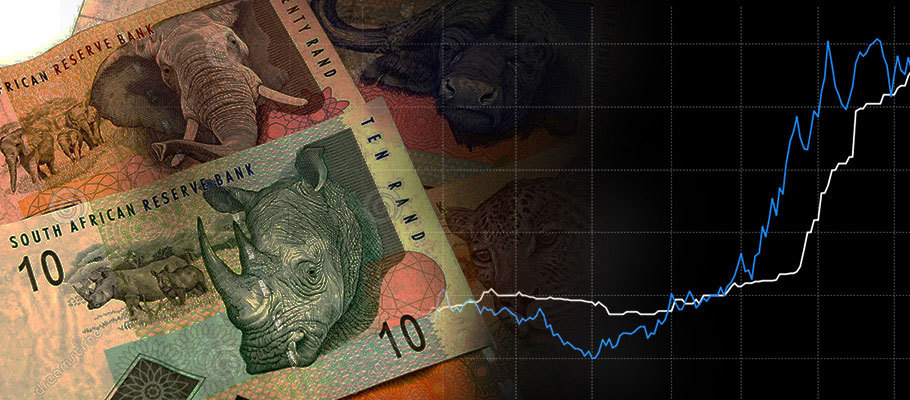
Published: June 5th, 2020
Rand (ZAR) has burnt a few forex traders’ fingers this month due to its rapid – and largely unexpected – recovery from record lows seen in April. Judging by the ongoing gap between analyst forecasts and the South African currency’s current level, there may be more casualties to come.
On 21st May the dollar/rand trade at TD Securities opened at R17.92 per dollar. It took only eight days for the position to be stopped out when ZAR strengthened at just below R17.45 –a 2.6 per cent loss.
Markets assumed that South African Reserve Bank easing would dent the currency’s appeal, but in fact, the opposite happened.
Bearish attitudes to ZAR extended to Bloomberg, where a survey of analysts forecast rand to reach R18.94 per dollar in Q2 – implying a decline of more than 7 per cent from the previous week’s R17.50 per dollar.
Bloomberg’s forecast model had the probability of rand weakening to that extent by the end of June at under 10 per cent.
Against the backdrop of South Africa’s deteriorating economic picture, and rising tensions between the US and China over Hong Kong’s political status, bearish analysts have been surprised by the timing of rand’s rebound.
ZAR strengthened by more than 5.5 per cent in May; the first monthly advance posted this year and its best performance since January 2019. Two key resistance levels were breached along the way: a 23.6 per cent Fibonacci retracement at R18.04 from April’s record low, and a 50-day moving average of around R18.20.
Analysts at Standard Bank Group Ltd. and Credit Suisse SA now think the next level to fall could be the 38.2 retracement at R17.24. A sustained breach could even see ZAR heading toward R16.50 per dollar; they told investors.
As countries move to scale back COVID-19 lockdown measures, rand has been helped by a tentative resurgence in global risk appetite. The currency also had some support in decisive moves by the central bank.
In a move designed to support an economy forecast to slide deeper into recession, the South African Reserve Bank changed tack on its aggressive easing policy on 21st May, after cutting the benchmark interest rate for the fourth time in four months.
There were also signals that record outflows from South Africa’s domestic bond market may be stemming. After selling off some R65 billion this year-to-date, foreign investors began re-acquiring local debt in the second half of May.
And there are other signs that ZAR holds more potential rewards for investors – if they’re willing to stay the course or risk opening new positions in what has historically been one of the globe’s most volatile emerging-market currencies.
In May, rand handed 6.2 per cent in returns to investors who borrow USD to buy high-yielding currencies, a practice known as the carry trade.
A strong signal of future opportunity, but other risks ahead.
The standoff between the US and China over Hong Kong, 5G deployments, and tariffs could spill over into emerging markets. The full economic and political impact of the coronavirus lockdown in South Africa, meanwhile, has yet to make itself fully known.
The questions on most traders’ minds have to be: what to make of ZAR’s recovery, and how long can it be sustained?
ZAR firmed more than one percent at the start of the week, lifted by hopes of a return to economic normalcy at home and abroad as more countries scale back coronavirus lockdowns.
Stock prices were also on the rise as mines, malls, factories and restaurants reopened and millions went back to work.
Rand also benefited from a general uplift in risk sentiment, as yield-seeking investors took heart from positive signs from China’s post-coronavirus economic recovery, and bet on an eventual thaw in US-China relations.
On Monday, the Trump administration removed Hong Kong’s special status on trade but stopped short of imposing new sanctions or tariffs on Beijing, even leaving the ‘Phase 1’ trade deal between the countries un-touched.
Investors were also encouraged by PMI numbers that showed unexpected (if marginal) improvement in Chinese factory activity the previous month.
Yield on the 10-year government fixed-income bond was down two basis points to 8.874 per cent.
The continent’s most industrialised economy was already in recession when COVID-19 struck. Central bank forecasts show GDP will shrink by more than six per cent this year, but economists have warned of an even deeper recession accompanied by painful job losses.
Yields on government bonds were offering investors some of the highest returns in the world (adjusted before inflation) before coronavirus restrictions on commerce and personal movement ravaged the economy, prompting a 2.75 per cent cut in central bank interest rates.
The cuts slashed positive real returns for international investors and South African savers. Analysts are now saying that ZAR has shifted bands and will most likely trade in the broad range of R17.49/R18.50 – but only so long as investors see the global economy at half-full rather than half-empty.
The rand’s recent gains arrive as South Africa prepares to move from level four to level three of its phased traffic light system designating restrictions on daily life.
Most sectors of the economy will reopen. The epidemiological curve for COVID in the country is still flattening, however, and medical experts warn of a second wave of infections that could move the country back up to level four.
Both Cape Town and Johannesburg are still seen as coronavirus ‘hotspots’, defined as a metropolitan census area with more than five infections per 100,000 people. Lockdown is being eased in both cities despite their hot spot status.
The threat of a second wave of infections threatens the rand as well, alongside the potential for Washington and Beijing to come to further blows in the weeks ahead.